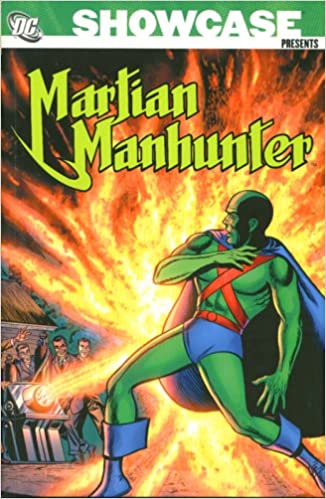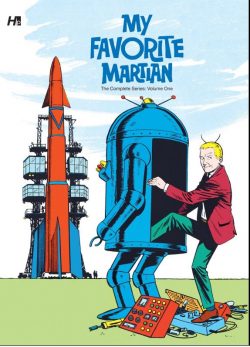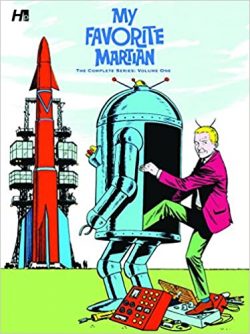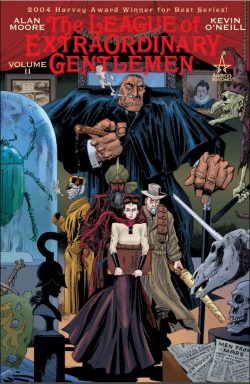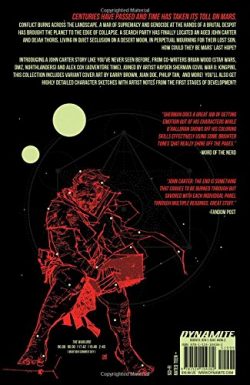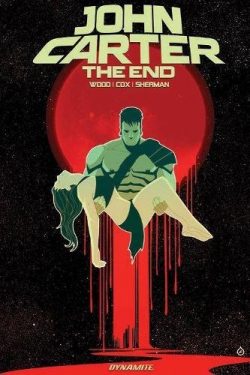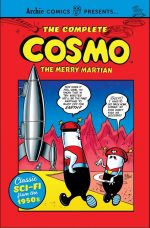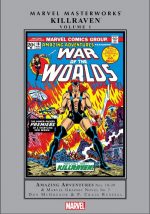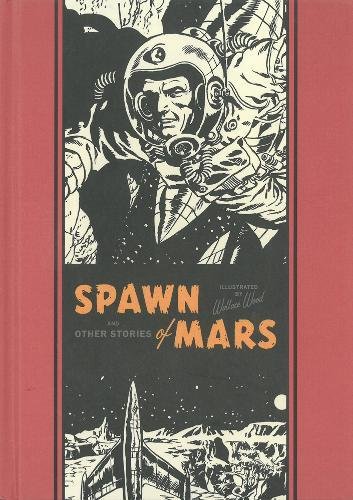

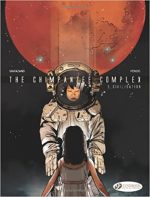
By Richard Marazano & Jean-Michel Ponzio, translated by Jerome Saincantin (Cinebook)
ISBN: 978-1-84918-002-3 (Album PB Paradox), 978-1-84918-015-3 (Album PB The Sons of Ares), 978-1-84918-043-6 (Album PB Civilisation)
One thing French comics creators excel at is challenging, mind-blowing, astoundingly entertaining science fiction. Whether the boisterous, mind-boggling space opera of Valerian and Laureline, the surreal spiritual exploration of Moebius’ Airtight Garage or the tense, tech-heavy brooding of Orbital, our Gallic cousins always got it: the genre is not about hardware or monsters; it’s about people encountering new and uncanny ideas…
Prolific, multi award-winning Richard Marazano was born in Fontenay-aux-Roses in 1971. He initially pursued a career in science before switching to Fine Arts courses in Angoulême. He debuted in bande dessinée in the mid 1990s. Although an extremely impressive artist and colourist when illustrating his own stories (Le Bataillon des Lâches, Le Syndrome d’Abel), he is best known for his collaborations with other artists such as Michel Durand (Cuervos), Marcelo Frusin (L’Expédition) and Xavier Delaporte (Chaabi) to name just a few.
His partnerships with artist Jean-Michel Ponzio are especially fruitful and rewarding. As well as Le Complexe du Chimpanzé – the trilogy under discussion here available singly in trade paper and digitally, but not yet in one epic edition – the daring duo produced the taut, intricate social futurism of Genetiksâ„¢ and high-flying paranoiac cautionary tale Le Protocole Pélican.
Jean-Michel Ponzio was born in Marignane and, after a period of scholastic pick-&-mix during the 1980s, began working as a filmmaker and animator for the advertising industry. He moved into movies, designing backgrounds and settings; listing Fight Club and Batman and Robin among his many subtle successes.
In 2000, he started moonlighting as an illustrator of book covers and edged into comics four years later, creating the art for Laurent Genfort’s T’ien Keou, before writing and illustrating Kybrilon for publisher Soliel in 2005. This led to a tidal wave of bande dessinée assignments before he began his association with Marazano in 2007. He’s still very, very busy and his stunning combination of photorealist painting, 3D design and rotoscoping techniques grace and enhance a multitude of comics from authors as varied as Richard Malka to Janhel.
Cinebook began publishing The Chimpanzee Complex in 2009 with the beguiling and enigmatic Paradox, which introduces the world to a bizarre and baffling cosmic conundrum…
February 2035: experienced but frustrated astronaut Helen Freeman is still reeling from the latest round of cutbacks which have once again mothballed NASA’s plans to send an expedition to Mars. The young mother is resigned to living an Earthbound life in Florida with the daughter she has neglected for so long, but just as she tentatively begins to repair her relationship with young, headstrong Sofia, her world is again turned upside down when a call comes from her ex-bosses.
Bowing to the inevitable despite Sophia’s strident objections, she and old boss Robert Conway are whisked away under the tightest of security conditions to a US aircraft carrier in the Indian Ocean under the draconian control of Top Brass Spook Konrad Stealberg.
Here they learn that, days previously, an unidentified object splashed down from space and was recovered by divers.
The artefact was the Command Module of Apollo 11 and it carried the still-living Neil Armstrong and Buzz Aldrin: legendary heroes forever mythologised as the first men to walk on the moon. Baffled and bewildered, the recovered astronauts have steadfastly refused to speak to anybody except NASA representatives…
Helen is the first to get any information from them, and whilst Stealberg’s technicians check every bolt, wire and component of the capsule, she and Robert carefully quiz their greatest idols. When the lost astronauts learn they have been in space for 66 years they are horrified. When they realise that history records they returned safely and died unremarkably years later, they go ballistic: exhibiting what Freeman describes as the traumatic shock response peculiar to space voyagers categorised by NASA as “the Chimpanzee Complexâ€â€¦
Impatient martinet Stealberg has harder questions: if – as every test they can think of indicates these men are the real thing, who or what landed on Earth all those decades ago?
And most importantly, when they were feted by the world in 1969, was third astronaut Michael Collins – who never walked on Luna – one of us or one of “themâ€?
Exerting military privilege, he peremptorily kicks Conway out whilst pressganging Helen onto his staff, and transfers the mystery-nauts and their capsule to his ultra-secure Red Hills Creek Base in Colorado…
Helpless but conflicted, Freeman plays along, enjoining Robby to explain and take care of Sofia. If she had been angry before, the daughter’s reaction to this further enforced absence from a mother she feels doesn’t want her will be terrible indeed…
Events move very fast at the paranoid levels of the Military-Industrial complex, and as Helen continues her interviews with the biologically-perfect astronauts, she begins to discover inconsistencies and memory-lapses in their stories.
That’s enough for Stealberg to initiate other, harsher procedures, but before they can be implemented Helen is awoken from fantastically real dreams of exploring Mars to a new crisis: Armstrong and Aldrin are dead. From the state of their corpses they have been for decades…
In Florida Robby is still trying to assuage Sofia’s feelings, telling her Mum will be home soon. There’s no chance of that, though, as Stealberg has moved on with his plans and arranged a private meeting with the President.
The result is the re-commissioning of the completed – but mothballed – Mars exploration shuttle, with the intention of revisiting the site of the Apollo moon landings. As NASA’s top flier and an expert on the Mars vehicle, Helen is going too… whether she wants to or not.
Twelve days later, amidst massive public uproar and speculation at the ludicrous cover story for the sudden moon-shot, Helen and her crew meet the rest of the exploration team and she realises with horror that her professional career is based on a lie.
NASA has never had an American monopoly on spaceflight: the military had been running a clandestine, parallel black-book program since the very start, funded by siphoning the Agency’s operating budget and personally instigated by ex-Nazi rocket pioneer Werner von Braun…
The launch is televised around the world, trumpeted as a final shakedown flight before closing the costly space program forever. Aboard the blazing javelin, Helen and close companion Aleksa ponder the coincidence of heading for the moon in the week they were originally scheduled to take off for Mars, but are more concerned that mission leader Stealberg has filled the shuttle with mysterious, classified containers…
All too soon, the vehicle establishes lunar orbit and a Lander touches down on the most hallowed site in the history of technology. It’s a huge shock: the paraphernalia left by the missions doesn’t match the records and there is a strange trail of footprints. Following them, the terrified explorers discover the mummified, space-suited, long-dead bodies of Armstrong and Aldrin, even as, high above them pilot Kurt matches velocities with a piece of space junk and discovers the Apollo 11 Command Module…with Collins’ corpse in it…
Moreover, there’s a recorded distress message in the primitive computers: a 66-year old Russian cry for aid originating from Mars…
And that’s when Stealberg reveals his biggest secret, summoning booster rockets and a second-stage shuttle from deep orbit whilst breaking out the cryogenic coffins that will keep the crew alive as they travel on to Mars and an appointment with the truth, whatever it might be…
Second volume The Sons of Ares opens in October 2035, focussing on Freeman’s best friend. NASA bureaucrat Robert Conway has struggled to look after the increasingly wayward Sofia. Increasingly off-the-rails, she argues and acts out, whilst in interplanetary space the fourth month of the journey finds American astronauts Paul Dupree and Mark Lawrence taking their boring turn awake for monitor duty, whilst their comrades endure resource-saving but life-shortening hibernation. The monotony is suddenly broken by a freak radiation storm. Only one of the terrified explorers makes it to the ship’s shielded area in time…
In Florida, Robert is acutely conscious of his failings as a surrogate parent, just as Helen is blissfully unaware of the personal crisis when her slumbering crew rouse from cold sleep to find Paul insane and Mark missing…
In reporting the situation to Earth, Helen again misses – or perhaps avoids – a chance to speak to Sofia – who is gradually coming to terms with the possibility that she might never see her mother again…
As the shuttle at last establishes Mars orbit, Paul is locked up for his own safety and the suspicious voyagers’ peace of mind. Konrad then shares intel gathered by his agents on Earth whilst they slept. The Soviet clandestine Cosmonaut project began in 1963, headed by space pioneer Yuri Gagarin – whose death had been faked to facilitate his smooth transition to commander of their Mars shot.
Expecting a monumental propaganda coup, the Kremlin simply said nothing when contact was lost with Gagarin’s mission, preferring stolid rhetoric to incontrovertible proof of failure. Now, with so many inexplicable events inevitably leading to the Red Planet, Stealberg expects Helen and her team to find all the answers with the Russians’ bodies on the dust surface. He couldn’t be more wrong…
Locating a base at the polar cap, Konrad dispatches his heavily armed crew to the site even as on Earth, Sofia runs away from home. However even whilst experiencing her greatest desire – walking on another world – Helen can’t help but worry about Paul, doped up and locked into the isolation chamber of the otherwise empty Shuttle…
Whilst Robert frantically searches for Sofia on Earth, the astronauts are astounded to discover the primitive landing site and corpses they expected are, in actuality, a thriving, efficient facility, stuffed with botanical wonders and manned by the very strong and vital cosmonauts who had landed there in the1960s.
After an initial exchange of hostilities – and gunfire – friendly contact is established and another incomprehensible tale unfolds. Russians Vladimir and Borislav have lost all sense of time in the “twelve years†since they landed and Commander Gargarin – having discovered a strange tunnel in a Martian glacier – has been absent for most of that period. They only know he’s still alive because food keeps vanishing…
Stealberg, seeing uncomfortable similarities in the agelessness of the cosmonauts and the duplicate Armstrong and Aldrin on Earth, sedates the Russians, who constantly ramble about the nature of reality, but Helen’s interest is piqued and, with Kurt’s assistance, she sneaks off into the glacier tunnel to find Gagarin…
When she succeeds, it only leads to more baffling questions. The First Man in Space perpetually stares into the unyielding ice-wall, seemingly unsurprised by Helen’s reports on the Apollo returnees, the impossible time-differentials and the fall of the Soviet Union.
He merely ruminates on Heisenberg’s Uncertainty Principle, and whether such a subatomic phenomenon could apply to larger constructs – such as human beings – in a constant and simultaneous state of being and non-being: a “probability of presenceâ€â€¦
They also converse about children they will probably never see again…
As Helen returns to the greenhouse module, the Russians are planning more armed resistance, but Stealberg has an even more pressing problem. Much to Helen’s astonished disbelief, he’s found Gagarin’s 60-years-dead corpse…
As Vladimir and Borislav attack, setting fire to the modules, the Americans fall back to their vehicle, dragging the now hysterical Helen, who has promised her very much alive Yuri Gagarin a ride home…
The tension increases when they re-enter the orbiting Shuttle: Paul has vanished and no trace can be found of him. Thoroughly rattled, Konrad orders an immediate return to Earth, with increased watches for every day of the trip.
May 2036: on Earth Robert has tracked down Sofia and they both eagerly await Helen’s return at Cape Canaveral. However, as the Shuttle nears Earth it suddenly vanishes from all tracking systems. Aboard the vessel, Helen and Kurt experience the horror of seeing their home planet vanish. Unable to brake the shuttle, and with no world in view, they rejoin the others in cold sleep, not knowing when they will next awaken or even if they will still be in their solar system when they do.
Helen’s last conscious thoughts are of the daughter she may never see again…
Concluding volume Civilisation completes the trilogy by picking up in the Great Unknown as hibernation ends after 70 years. Only Helen and Aleksa remain alive, all the other cryo-capsules having failed at some indeterminate time.
With only finite resources and dwindling power, Helen consoles herself by catching up on messages beamed in hope and anticipation by Robbie Cooper, but is roused from her fatalistic depression by Aleksa who has made a shocking discovery…
Seeing one of the EVA suits missing, he at first believed their comrade Alex had committed suicide by walking out of the airlock. Then he saw the impossibly huge unidentified space ship and called Helen…
Suiting up and arming themselves, they cross to the vessel, Helen further encumbered by a laptop with all the messages – read and unread – from Cooper stored on it. They have no idea when Alex left, or if she even tried to reach the UFO. However, as it’s their only hope of survival, they make a leap into the void and, after great struggle, find themselves in a vast and terrifying mechanical chamber of disturbing proportions.
Alex’s abandoned gear is on the floor. She had clearly camped there for some time before vanishing into the dark, dusty cavernous interior…
Whilst they rest and consider their next move, Helen watches the last message Robbie sent from Earth. It is sixty-seven years old…
Later, Helen freaks out when they find Alex’s empty suit, until Aleksa does the unthinkable and opens his own EVA garb. The enigma ship has warmth and a breathable atmosphere…
And then something pushes part of the vessel over on them…
Narrowly escaping harm, they cautiously explore the vessel, but after splitting up Aleksa is attacked again. When terrified Helen finds him, he is hugging the crazed, decrepit, wizened but still alive Alex. Mute but still vital, she leads them through vaulting passageways to what they can only assume is a skeleton. A really, really big one. Outside a viewing portal, Mars spins by above them. It’s as if they’ve come home…
However fast or far or forward humanity travels, their fears and foibles go with them and before long distrust and dread spark a final confrontation in the uncanny construct. Thus, only one person makes an implausible, inexplicable escape back to Earth…
It’s 2097 and as a long-missing craft splashes down in the ocean to begin the circle anew, it becomes clear that some mysteries, like some philosophies and some family bonds, remain ineffably beyond the sphere of rational thinking…
Bold, challenging and enticingly human, this astonishing science mystery dances and darts adroitly between beguiling metaphysics and hard-wired mortal passions, easily encompassing our species’ inbuilt inescapable isolation, wide-eyed wonderment, hunger to know everything and terror of finding out. Marazano’s pared-to-the-bone script is brought to hyper-life with stunning clarity by Ponzio to produce a timeless fusion of passion, paranoia and familial fulfilment. A deft blend of intrigue, hope, paranoia and abiding curiosity, The Chimpanzee Complex is a tale no lover of fantasy and suspense should ignore.
Do you read me? Do read The Chimpanzee Complex.
© Dargaud, Paris, 2007, 2008 by Marazano& Ponzio. All rights reserved. English translation © 2009, 2010 Cinebook Ltd.

